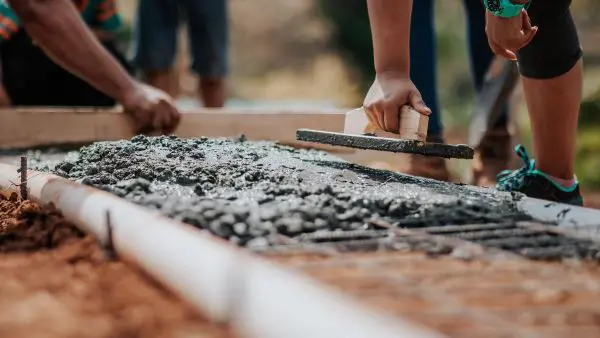12 sustainable alternatives to traditional concrete
Posted on: 12 February, 2024

Concrete, the second most-consumed substance in the world behind water, is also one of the most damaging to the environment. Here are 12 sustainable alternatives.
The sector-wide push to realise a sustainable built environment has brought forth many innovations. From methodologies like lean construction and the use of modular and prefabrication techniques to retrofitting and other alternatives to traditional demolition, progress is being made to ensure the building lifecycle works in harmony with a sustainable, net zero future.
If our sector is to play its part in combating and adapting to the ongoing climate crisis, every aspect of the construction process – from design and planning to development, operation and the end-of-life phase – needs to be analysed to unearth new opportunities for greener, more sustainable practices and techniques.
This innovation has helped pioneer new alternatives to one of the most traditional yet environmentally damaging materials in the entire construction process – concrete.
What’s the problem with traditional concrete?
The impact the built environment has on climate change is well documented, and one of the biggest contributors to our sector’s emissions is concrete.
Cement manufacturing and concrete production accounts for more emissions than the entire aviation industry – around 8%. What’s more, emissions from this industry have doubled in the last twenty years, and 30 billion tonnes of concrete is used each year – three times as much as 40 years ago. In fact, concrete is the second-most consumed substance in the world, after water.
If the built environment is to truly align with net zero and the Sustainable Development Goals (SDGs) set out by the United Nations, businesses and construction firms need to start using some of the emerging sustainable alternatives to this material.
12 sustainable alternatives to traditional concrete
Below are 12 substitutes for concrete that could offer sustainability benefits for the built environment:
1. Green concrete
Green concrete is different from its traditional counterpart in several ways:
- It uses waste material in its composition as a substitute for cement
- It requires less energy for production, producing less carbon dioxide and reducing environmental damage
- It’s more durable and requires less maintenance, increasing longevity
Green concrete was developed in Denmark in 1998 and makes uses of waste from a variety of sources, including power plants, mining and quarrying and incinerator residue. The use of these waste materials makes it easier to place and finish, improves quality and reduces permeability, helping protect it from water damage and prevent cracking. What’s more, it’s also more cost-effective, as it reduces the need for new material and, subsequently, transportation.
2. Aggregate replacement (e.g. papercrete)
Concrete itself is a mixture of cement, aggregates, and water, so along with alternatives to cement, replacing the fine and coarse aggregates in the mix is another option for improved sustainability. These alternative materials, such as glass, plastic, paper, rubber and fly ash clay, help reduce energy consumption and offer cost-saving benefits. However, depending on the replacement aggregate you use, the properties of the material, such as its compressive strength and resistance to corrosive substances, could be impacted.
3. Ashcrete
Ashcrete is another greener alternative to concrete that makes use of waste – this time the fly ash discarded from the combustion of coal. Around 93% of ashcrete is made from recycled material. The use of this fly ash increases the strength, resilience and durability of the mixture, while also proving a cost-effective concrete alternative.
On the other hand, the time required to set ashcrete and develop strength in the mixture is longer than traditional concrete, which could have a knock-on impact to the length of a construction project.
4. Micro silica
Micro silica, also known as silica fume, is a byproduct from silicon metal industries. This ultra-fine powder offers strength enhancement and corrosion resistance benefits over traditional material by reducing permeability and could be used to replace between 7% and 12% of the cement found in mixtures. However, as with ashcrete, the use of micro silica does make the construction process more complex, as the resulting substance is less workable and not as easy to plaster.
5. Blast furnace slag
Another waste product that improves the strength of concrete, blast furnace slag is obtained from steel manufacturing and refined into ground granulated blast furnace slag (GGBFS). The fine nature of this material means it has high workability and reduced permeability. However, this comes at the cost of low initial strength and increased initial setting time, meaning it isn’t ideal for emergency works.
6. Concrete debris
What better way to address the environmental impact of making cement than to recycle it for new building projects? While concrete debris is often left as rubble during the demolition process (making up around 85% of all construction waste, according to estimates), it can instead be deconstructed. This can offer a range of benefits, from greater stability and enhanced production turnaround to an overall and immediate reduction of CO2 emissions.
7. Grasscrete
Grasscrete is another sustainable alternative frequently used in paving. This method involves laying concrete while allowing patterns for grass and flora, creating a natural biophilic element to walkways and flooring while improving rainwater absorption and drainage. What’s more, the incorporation of flora means you’ll need to use less concrete, and this method can also be used in conjunction with many of the other alternative materials listed here.
8. Recycled plastic waste
How we deal with discarded plastic waste is one of the most frequently cited sustainability challenges we’re facing. Fortunately, the construction industry can help through the incorporation of this non-biodegradable material as an aggregate.
Using plastic can help reduce the amount of CO2 produced in its creation, along with decreasing transportation costs and the requirement for structural support. However, it can potentially lead to an overall weakening of the material’s strength, as plastic doesn’t mix well as sand.
9. Mycelium
Mycelium is seen as one of the most exciting alternatives to concrete emerging in the construction industry. This material is sourced from miniscule threads in mushrooms and, when mixed with organic matter, forms a dense, durable and naturally fire-resistant material that can be moulded easily into any shape.
While the challenge with mycelium is its lack of strength compared to standard concrete, it is significantly lighter and more environmentally friendly. It’s already being used as a packaging material and, according to experts, could be used to clean up other environmentally damaging industries like fashion and oil.
Learn more: 14 building materials shaping the future of the built environment
10. Hempcrete
Another particularly interesting alternative to concrete emerging in the built environment is hempcrete. Hemp has already been utilised by manufacturers in various industries, including food and fuel, and with hemp fibres being easy to grow and produce, it’s an accessible and sustainable option the construction industry should consider.
One of the chief benefits of hempcrete is its weight, being significantly lighter than traditional concrete. It also has superior thermal properties.
11. Self-healing concrete
As highlighted with the recent publicity around reinforced autoclaved aerated concrete (RAAC), one of the biggest risks with concrete is the risks of cracks, most often caused by stress or shrinkage. Various factors, from the aggregates used to the amount of water added during the mixing process, can contribute to how cracked it becomes.
Self-healing concrete is a phenomenon where concrete repairs cracks through the use of bacterial reactions. This smart material is made by adding materials containing adhesive liquids into the mix and can help double its lifespan.
12. Bamboo
Bamboo is well known for its strength properties and has been used for building for thousands of years, but it’s also emerging as a sustainable alternative to concrete. Like hemp, it grows extremely fast, meaning its easy and sustainable to produce. It also has increased tensile strength, improved flexibility, and enhanced resistance to corrosion. This makes it an attractive option for construction companies, as it can be used in everything from flooring slabs to scaffolding and roof shingles.






